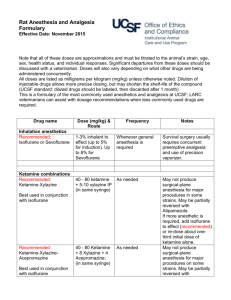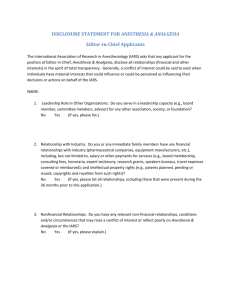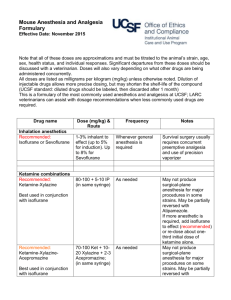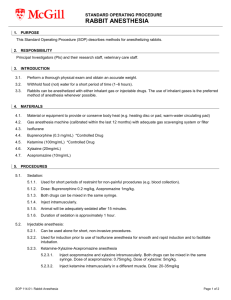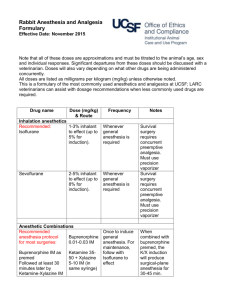Anesthetic_Doses_201..
advertisement
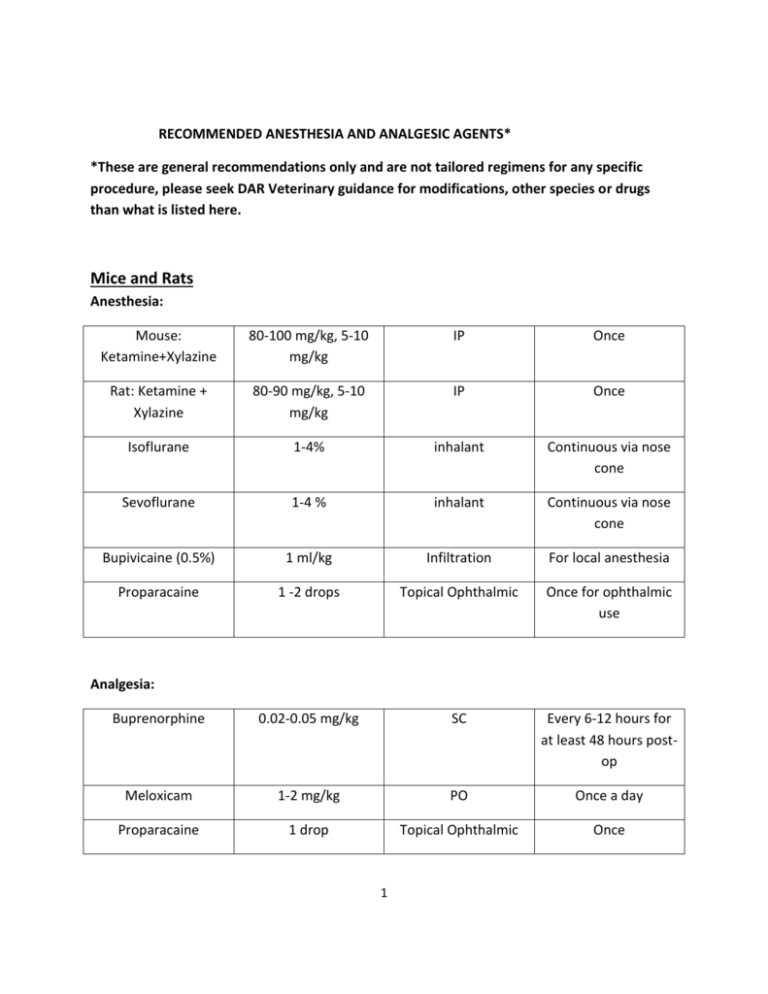
RECOMMENDED ANESTHESIA AND ANALGESIC AGENTS* *These are general recommendations only and are not tailored regimens for any specific procedure, please seek DAR Veterinary guidance for modifications, other species or drugs than what is listed here. Mice and Rats Anesthesia: Mouse: Ketamine+Xylazine 80-100 mg/kg, 5-10 mg/kg IP Once Rat: Ketamine + Xylazine 80-90 mg/kg, 5-10 mg/kg IP Once Isoflurane 1-4% inhalant Continuous via nose cone Sevoflurane 1-4 % inhalant Continuous via nose cone Bupivicaine (0.5%) 1 ml/kg Infiltration For local anesthesia Proparacaine 1 -2 drops Topical Ophthalmic Once for ophthalmic use Buprenorphine 0.02-0.05 mg/kg SC Every 6-12 hours for at least 48 hours postop Meloxicam 1-2 mg/kg PO Once a day Proparacaine 1 drop Topical Ophthalmic Once Analgesia: 1 Ketoprofen 5mg/kg SC Once a day AGENT DOSAGE ROUTE FREQUENCY OF ADMINISTRATION Ketamine+Xylazine 35-50 mg/kg, 5-10 mg/kg IM Once Acepromazine 0.75-1.0 mg/kg SC Once Isoflurane 1-4 % inhalant Continuous via endotracheal intubation Sevoflurane 1-4 % inhalant Continuous via endotracheal intubation Bupivicaine (0.5%) 1 ml/kg Infiltration For local anesthesia Proparacaine 1 -2 drops Topical Ophthalmic Once for ophthalmic use Buprenorphine 0.01-0.05 mg/kg SC Every 12 hours for at least 48 hours postop Meloxicam 0.1-0.3 mg/kg PO Once a day Rabbit Anesthesia: Analgesia: Guinea Pig Anesthesia: 2 Ketamine+Xylazine 20-40 mg/kg + 2 mg/kg IM, IP Once Isoflurane 1-4% inhalant Continuous via nose cone Sevoflurane 1-4 % inhalant Continuous via nose cone Bupivicaine (0.5%) 1 ml/kg Infiltration For local anesthesia Proparacaine 1 -2 drops Topical Ophthalmic Once for ophthalmic use Buprenorphine 0.05 -0.1mg/kg SC Every 8-12 hours for at least 48 hours postop Meloxicam 0.5-0.mg/kg PO Once a day Ketamine+Xylazine 80mg/kg + 5 mg/kg IM, IP Once Isoflurane 1-4% inhalant Continuous via nose cone Sevoflurane 1-4 % inhalant Continuous via nose cone Bupivicaine (0.5%) 1 ml/kg Infiltration For local anesthesia Proparacaine 1 -2 drops Topical Ophthalmic Once for ophthalmic Analgesia: Hamsters Anesthesia: 3 use Analgesia: Buprenorphine 0.05 -0.5mg/kg SC Every 8 hours for at least 48 hours postop Meloxicam 0.5-0. mg/kg PO Once a day Ketamine+Xylazine 50mg/kg + 2 mg/kg IM, IP Once Isoflurane 1-4% inhalant Continuous via nose cone Sevoflurane 1-4 % inhalant Continuous via nose cone Bupivicaine (0.5%) 1 ml/kg Infiltration For local anesthesia Proparacaine 1 -2 drops Topical Ophthalmic Once for ophthalmic use Buprenorphine 0.1 -0.2mg/kg SC Every 8 hours for at least 48 hours postop Meloxicam 0.5-0.mg/kg PO Once a day Gerbils Anesthesia: Analgesia: 4 Non-Human Primates- Macaca sp. Anesthesia: Ketamine 5-20mg/kg IM Once Ketamine/Medetomidine 3.0 mg/kg, 0.15 mg/kg IM Once KetamineDiazepam 5-10mg/kg,.35mg/kg IM Once Isoflurane 1-2% on 100% Oxygen Inhalant Continuous via endotracheal intubation Thiopental 5-7 mg/kg IV To effect for induction Sevoflurane 2-4% on 100% Oxygen Inhalant Continuous via endotracheal intubation Propofol 2.5-5.0 mg/kg IV Bolus then infusion at 0.3-0.4 mg/kg/min Telazol 1.5-3.0 mg/kg IM Induction Analgesia: Buprenorphine 0.01 -0.02mg/kg IM, SQ Every 12 hours for at least 48 hours postop Ibuprofen 7 mg/kg PO Once a day Meloxicam 0.2 mg/kg PO Once a day Swine 5 Anesthesia: Telazol/Xylazine 2.2 – 4.4 mg/kg IM For induction Thiopental 5 – 20 mg/kg IV For induction Isoflurane 1- 4 % inhalation Continuous via endotracheal intubation Sevoflurane 1-4 % inhalation Continuous via endotracheal intubation Bupivacaine (.5%) 1ml/kg infiltration For local anesthesia Proparacaine 1-2 drops ophthalmic For ophthalmic use Buprenorphine 0.005 -0.02 mg/kg IM Every 8- 12 hrs Carprofen 2 – 4 mg/kg PO Every 12 hrs Acepromazine 0.05-0.1 mg/kg SC, IM, IV Once Propofol 2.5 – 5 mg/kg IV Bolus then infusion at 0.3-0.4 mg/kg/min Thiopental 5 –20 mg/kg IV To effect Ketamine /diazepam 5-10mg/.25-.5mg/kg IV To effect Isoflurane 1-4% inhalation Continuous via endotracheal Analgesia: Canine Anesthesia: 6 intubation Sevoflurane 1-4% Inhalation Continuous via endotracheal intubation Bupivacaine (.5%) 1ml/kg infiltration For local anesthesia Proparacaine 1-2 drops ocular/ophthalmic For ophthalmic use Buprenorphine .01-.02 mg/kg SC Every 8-12 hrs Carprofen 2mg/kg PO Every 12 hrs Analgesia: Cat Anesthesia: Propofol 2.5 – 5 mg/kg IV Bolus then infusion at 0.3-0.4 mg/kg/min Ketamine/Ace/Butorphanol (KAB) 50 mg/kg, 0.2 mg/kg, 0.05 mg/kg IM Sedation/induction Telazol 5-7.5 or IV or 10-15 mg/kg IM Induction and sedation Isoflurane 1-4% inhalation Continuous via endotracheal intubation Sevoflurane 1-4% Inhalation Continuous via endotracheal 7 intubation Bupivacaine (.5%) 1ml/kg infiltration For local anesthesia Proparacaine 1-2 drops ocular/ophthalmic For ophthalmic use Analgesia: Buprenorphine .01-.02 mg/kg SC Every 8-12 hrs Ketoprofen 1 mg/kg PO Every 24 hours Meloxicam 0.1-0.2 mg/kg IM Every 24-48 hours Midazolam 2-6 mg/kg IM For light sedation Telazol 5-10 mg/kg IM For induction Propofol 1.3-14 mg/kg IV For induction Isoflurane 1.5-5 % inhalation Continuous via intubation or mask Ketamine/Xylazine 10-50 mg/kg and 1-10 mg/kg IM Sedation Avian species Anesthesia: Ketamine/Midazolam 10-40 mg/kg (<250 g birds) 8 Analgesia: Buprenorphine 0.01-0.03 mg/kg SC,IM, IV Every 8- 12hrs Carprofen 1 mg/kg PO Every 24 hours Ketoprofen 1mg/kg PO Every 24 hours Propofol 5-15 mg/kg IV, IO For induction Isoflurane 1-3 % Inhalation Continuous via endotracheal intubation or mask Buprenorphine 0.005-0.02 mg/kg IM Every 24-48 hours Carprofen 1-4 mg/kg PO, SC, IM, IV Every 24 hours Reptiles Anesthesia: Analgesia: Then ½ dose every 24-72 hours Ketoprofen 2 mg/kg SC, IM Every 24 hours Meloxicam 0.1-0.2 mg/kg IM Every 24-48 hours Immersion Induction Fish Anesthesia: Buffered MS-222*** (Tricaine 50-100 mg/L 9 Methanesulfonate) 50-60 mg/L Maintenance Amphibians Anesthesia: Buffered MS-222*** 200-500 mg/L (larval, aquatic) Immersion Induction and anesthesia 9.5 mg/kg IC For sedation 30 mg/kg IC For Anesthesia 1-3 g/L (toads) 500 mg L-2 g/L (Salamanders, Frogs) Propofol Ketamine 50-150 mg/kg SC, IM, IV Induction Isoflurane 3-5% (terrestrial) Inhalant Induction 1-2% Maintenance Bubbled into water until effect (aquatic) Analgesia: Morphine 38-42 mg/kg SC Naked Mole Rats Anesthesia: 10 Every 4 hours Isoflurane 1-4 % inhalation Continuous via mask down or intubation Ketamine/xylazine 50 mg/kg and 3mg/kg IP For sedation 1mg/kg PO Every 24 hours Acepromazine 0.1-0.25 mg/kg SC/IM For light sedation Thiopental 8-12 mg/kg IV For induction Propofol 2-5 mg/kg IV For induction Isoflurane 1-4 % inhalation Continuous via endotracheal intubation or mask Ketamine 20-35 mg/kg IM For sedation only Analgesia: Ketoprofen Ferrets Anesthesia: Analgesia: Buprenorphine 0.01-0.03 mg/kg SC,IM, IV Every 8- 12hrs Carprofen 1 mg/kg PO Every 24 hours Ketoprofen 1mg/kg PO Every 24 hours Meloxicam 0.2 mg/kg SC Every 24 hours 11 * PO- Oral IM- Intramuscular IV- Intravenous SQ- Subcutaneous IP- Intraperitoneal IC-Intracoelomic IO-Intraosseous ** Frequency = time interval between doses. ***Tricaine Methanesulfonate, also known as MS-222 must be buffered with Sodium Bicarbonate to a pH of 7-7.5 and stored in an airtight container at room temperature. Water must not be buffered before adding the anesthetic solution. A popular concentration is 10 g/L for a stock solution. If an oily substance forms on the surface, the solution must be discarded. This solution is light sensitive so it must be stored in a dark container away from sunlight. References: Artwohl J et al; 2009. Extreme Susceptibility of African Naked Mole Rats (Heterocephalus glaber) to Experimental Infection with Herpes Simplex Virus Type 1. Comparative Medicine. 59(1) 83-90. Anesthesia and Analgesia in Laboratory Animals Laboratory Animal Medicine Second Edition 12 Formulary for Laboratory Animals Third Edition 2005 Carpenter, James; 2005. Exotic Animal Formulary 3rd Ed. Elsevier Saunders, St. Louis, MO. . 13
